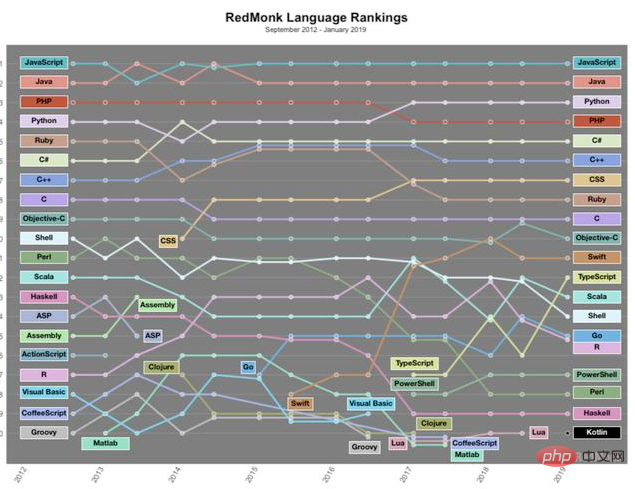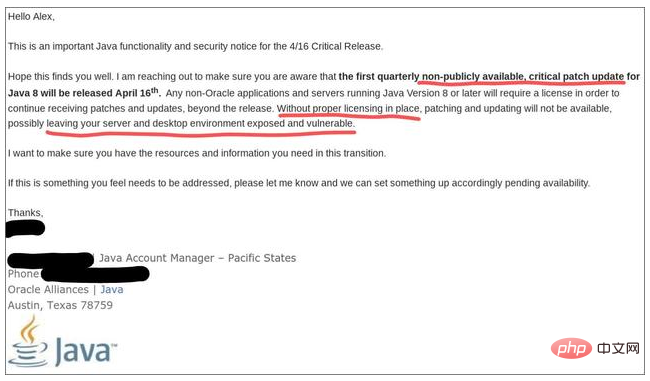 headlines
headlines
 When programming languages are in the hands of enterprises, is it a chance of survival or a crisis?
When programming languages are in the hands of enterprises, is it a chance of survival or a crisis?
When programming languages are in the hands of enterprises, is it a chance of survival or a crisis?
In April 2019, the Java 8 charging era has arrived! In January 2019, Oracle announced that it would stop free support for Java 8 updates, and future Java updates would only be available to paid license holders. Recently, Oracle sent an email to inform users that Java 8’s first, paid quarterly major patch update will be released on April 16.

Industry analysis company Redmonk recently released the programming language rankings for the first quarter of 2019. The top ten are JavaScript, Java , Python, PHP, C#, C, CSS, Ruby, C and Objective-C. The RedMonk programming language rankings are published twice a year. They are mainly based on the code usage and number of discussions of programming languages on GitHub and Stack Overflow. After statistical analysis, the rankings are sorted to determine the future adoption trends of programming languages.
I believe many people will have a little doubt when they see RedMonk's rankings. This is a bit different from the programming language rankings released by TIOBE. The Top 10 programming languages released by TIOBE in March are: Java, C, Python, Visual Basic .NET, C#, JavaScript, PHP, SQL and Objective-C.

#When programming languages are in the hands of enterprises, is it life or crisis?
However, if you carefully compare the two programming language rankings, you will find that 7 of the top 10 programming languages are the same, but the rankings are slightly different. In fact, the competition for the top programming languages has always been relatively stable. RedMonk’s top five players, JavaScript, Java, PHP, Python and C#, have not changed since 2014, and even the ranking order has only appeared a few times. Small changes.
Excluding the top players and expanding the scope of observation to the Top 20 programming languages, you will find a more interesting phenomenon, that is, the programming languages that are rising rapidly are supported by companies. Taking the RedMonk list as an example, let's take a look at these "background" programming languages:
• Objecr-C, ranked 10th: Objective-C was originally developed by Brad Cox and Tom Love , but was later "acquired" by Apple.
• Swift ranked 11th: Swift is a new development language released by Apple in 2014. It is easy to learn and use.
• TypeScript ranked 12th: TypeScript was originally an internal project of Microsoft. In 2014, Microsoft officially released the language.
• Go:Go, ranked 15th, was developed in 2007 by Google employees Robert Griesemer, Rob Pike and Ken Thompson. It was open sourced in 2009 and quickly became the core language for building cloud applications.
• Kotlin at No. 20: Kotlin was originally developed by JetBrains and was “acquired” by Google in 2017 for Android development.
In fact, early Web languages were basically written by individual hackers. For example, PHP was written by Rasmus Lerdorf, and Python was written by Guido Van Rossum. The late 1990s was the golden age of Internet development. A large number of grassroots projects and small projects emerged at that time, which later developed into large-scale projects. Take programming languages as an example. At that time, people no longer used C language to build CGI web applications, but were actively adopting other languages such as PHP and JavaScript.
"Father of C" Bjarne Stroustrup began to study C when he was studying for his PhD. However, it was not until 1983 that he used C at AT&T. When he recalled this experience, he said:
When I was developing C, AT&T was actually facing a dilemma. The systems AT&T built were more complex and had higher reliability requirements than most organizations, so we had to influence the market ourselves and develop standards that met our own needs. , otherwise we would not have the tools to build the system. Before I developed C, Ken Thompson and Dennis Ritchie had developed Unix and C. AT&T is probably the largest "civilian user" of software tools in the world, and we use them on a much wider range of systems: from the smallest embedded processors to the largest supercomputers and data processing systems. Therefore, our idea at the time was that this language should be applicable to as many of these technical cultures and platforms as possible. Versatility is critical, and proprietary features can be seen as limiting platform and vendor choices. Therefore, AT&T was, and still is, a major supporter of formal standards (e.g., ISO C, ISO C). In other words, AT&T pushed C to become an industry standard, and C became an industry norm through AT&T from the whim of a PhD student.
But when time travels to the 21st century, this situation has changed. If the "Internet" benefited the people in the early days, then when the next wave of mobile applications arrived, the leaders became enterprises. Language rules are dominated by Google, Apple, and Microsoft.
Many emerging languages are sponsored by companies from the beginning, such as Microsoft's CNo. These new programming languages learn from past experiences and lessons. By default, each new language is open source and will not Yet another case of a company trying to build a proprietary program in a proprietary language. Of course, there are also languages that were originally developed by hackers that have been "adopted" by companies, such as Objective-C.
During this period, much of the future of the web and apps was built on corporate cash rather than community momentum. So, is this situation good or bad?
It is not difficult to see from the above that a large part of the popular programming languages are backed by corporate investment. The advantage of corporate investment is that there is sufficient funds, and the programming language can develop continuously and steadily without sudden death. But there are also drawbacks, that is, companies may make profits from it. For example, Swift takes 30% of the fee for every application built using Swift.
What’s even more frightening is that enterprise-dominated programming languages may lead to ecosystem lock-in, and open source programming languages are an important part of forming this lock-in. Once an enterprise's ecosystem and applications rely heavily on a certain programming language and cannot be easily replaced, it is likely to be led by the company behind the programming language, just like Oracle's previous "vendors" in the database field. Lock-in” and IBM’s “vendor lock-in” in the mainframe field.
The "vendor lock-in" of programming languages is not far away. In the near future, the Java 8 update will start to be charged! In January 2019, Oracle announced that it would stop free support for Java 8 updates. Future Java updates will only be available to paid license holders. Users without valid licenses cannot use Java 8 security updates for commercial purposes.
When programming languages are in the hands of enterprises, is it life or crisis?

(Picture source network, a reminder email sent by Oracle to users about Java 8 charges)
Starting from April 2019, Oracle Major patch updates to Java 8 will be released quarterly, and the first non-public major patch update will be released on April 16. In many enterprise applications, Java 8 is still the main force. I believe Oracle's charging move will have an impact on many enterprises.

Hot AI Tools

Undresser.AI Undress
AI-powered app for creating realistic nude photos

AI Clothes Remover
Online AI tool for removing clothes from photos.

Undress AI Tool
Undress images for free

Clothoff.io
AI clothes remover

Video Face Swap
Swap faces in any video effortlessly with our completely free AI face swap tool!

Hot Article

Hot Tools

Notepad++7.3.1
Easy-to-use and free code editor

SublimeText3 Chinese version
Chinese version, very easy to use

Zend Studio 13.0.1
Powerful PHP integrated development environment

Dreamweaver CS6
Visual web development tools

SublimeText3 Mac version
God-level code editing software (SublimeText3)

Hot Topics
 PHP and Python: Different Paradigms Explained
Apr 18, 2025 am 12:26 AM
PHP and Python: Different Paradigms Explained
Apr 18, 2025 am 12:26 AM
PHP is mainly procedural programming, but also supports object-oriented programming (OOP); Python supports a variety of paradigms, including OOP, functional and procedural programming. PHP is suitable for web development, and Python is suitable for a variety of applications such as data analysis and machine learning.
 Choosing Between PHP and Python: A Guide
Apr 18, 2025 am 12:24 AM
Choosing Between PHP and Python: A Guide
Apr 18, 2025 am 12:24 AM
PHP is suitable for web development and rapid prototyping, and Python is suitable for data science and machine learning. 1.PHP is used for dynamic web development, with simple syntax and suitable for rapid development. 2. Python has concise syntax, is suitable for multiple fields, and has a strong library ecosystem.
 PHP and Python: A Deep Dive into Their History
Apr 18, 2025 am 12:25 AM
PHP and Python: A Deep Dive into Their History
Apr 18, 2025 am 12:25 AM
PHP originated in 1994 and was developed by RasmusLerdorf. It was originally used to track website visitors and gradually evolved into a server-side scripting language and was widely used in web development. Python was developed by Guidovan Rossum in the late 1980s and was first released in 1991. It emphasizes code readability and simplicity, and is suitable for scientific computing, data analysis and other fields.
 PHP's Impact: Web Development and Beyond
Apr 18, 2025 am 12:10 AM
PHP's Impact: Web Development and Beyond
Apr 18, 2025 am 12:10 AM
PHPhassignificantlyimpactedwebdevelopmentandextendsbeyondit.1)ItpowersmajorplatformslikeWordPressandexcelsindatabaseinteractions.2)PHP'sadaptabilityallowsittoscaleforlargeapplicationsusingframeworkslikeLaravel.3)Beyondweb,PHPisusedincommand-linescrip
 PHP vs. Python: Use Cases and Applications
Apr 17, 2025 am 12:23 AM
PHP vs. Python: Use Cases and Applications
Apr 17, 2025 am 12:23 AM
PHP is suitable for web development and content management systems, and Python is suitable for data science, machine learning and automation scripts. 1.PHP performs well in building fast and scalable websites and applications and is commonly used in CMS such as WordPress. 2. Python has performed outstandingly in the fields of data science and machine learning, with rich libraries such as NumPy and TensorFlow.
 The Continued Use of PHP: Reasons for Its Endurance
Apr 19, 2025 am 12:23 AM
The Continued Use of PHP: Reasons for Its Endurance
Apr 19, 2025 am 12:23 AM
What’s still popular is the ease of use, flexibility and a strong ecosystem. 1) Ease of use and simple syntax make it the first choice for beginners. 2) Closely integrated with web development, excellent interaction with HTTP requests and database. 3) The huge ecosystem provides a wealth of tools and libraries. 4) Active community and open source nature adapts them to new needs and technology trends.
 MySQL vs. Other Programming Languages: A Comparison
Apr 19, 2025 am 12:22 AM
MySQL vs. Other Programming Languages: A Comparison
Apr 19, 2025 am 12:22 AM
Compared with other programming languages, MySQL is mainly used to store and manage data, while other languages such as Python, Java, and C are used for logical processing and application development. MySQL is known for its high performance, scalability and cross-platform support, suitable for data management needs, while other languages have advantages in their respective fields such as data analytics, enterprise applications, and system programming.
 Golang vs. Python: Performance and Scalability
Apr 19, 2025 am 12:18 AM
Golang vs. Python: Performance and Scalability
Apr 19, 2025 am 12:18 AM
Golang is better than Python in terms of performance and scalability. 1) Golang's compilation-type characteristics and efficient concurrency model make it perform well in high concurrency scenarios. 2) Python, as an interpreted language, executes slowly, but can optimize performance through tools such as Cython.




